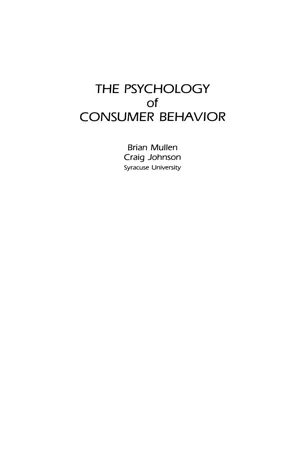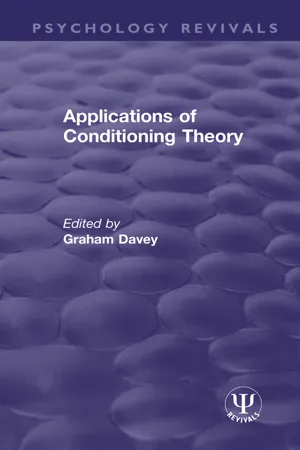Psychology
Conditioning
Conditioning refers to the process of learning and behavior modification through the association of stimuli with specific responses. In classical conditioning, a neutral stimulus becomes associated with a meaningful stimulus, leading to a learned response. Operant conditioning involves learning through reinforcement or punishment of behaviors. These processes are fundamental to understanding human and animal behavior.
Written by Perlego with AI-assistance
Related key terms
6 Key excerpts on "Conditioning"
- Nancy Fenton, Jessica Flitter(Authors)
- 2015(Publication Date)
- Research & Education Association(Publisher)
Chapter 8 LearningPsychologists define learning as an enduring or relatively permanent change in an organism caused by experience or influences in the environment. Behaviors that are caused by factors such as fatigue, intoxication, or illness are not considered to be the result of learning because they are not long-lasting or permanent. Changes in an organism due to normal growth, aging or genetics are also not the result of learning because they were not caused by experience or environmental influences. Much of the understanding of how learning works is the result of discoveries made by behaviorists. According to early behaviorists , including John B. Watson and B.F. Skinner, psychology should include the investigation of only observable and measurable behaviors. Although the study of learning is typically associated with the perspective of behaviorism, learning is also influenced by biological, cognitive, and social factors. Psychology involves the identification and investigation of a variety of types of learning that include classical Conditioning, operant Conditioning, observational learning, and the impact of cognition and biology on learning.STUDY TIPBe able to identify the stimulus and response relationship between the environment and an organism involved in learning.Any factor in the environment that causes a reaction is known as a stimulus, and any reaction by an organism that is either voluntary or involuntary is called a response.Classical ConditioningHistorically, the psychological study of learning began in Ivan Pavlov’s laboratory in Russia in the late nineteenth century. Pavlov was initially studying what he called the salivation reflex or the involuntary behavior of salivating in response to meat powder placed in the mouths of dogs. While conducting research, a problem occurred, because the dogs began to salivate before the meat powder was placed in their mouth in response to the sight or sound of the experimenter. The dogs were anticipating the arrival of the meat powder. Based on this observation, Pavlov began the investigation of how organisms learn by association. In 1904 Pavlov was awarded the Nobel Prize in medicine and physiology for his investigation into what is now known as classical Conditioning. Classical Conditioning (Pavlovian Conditioning) is a type of learning that involves pairing a previously neutral stimulus with an unlearned stimulus to generate a learned response. Classical Conditioning is based on involuntary responses that include reflexes. A reflex- eBook - ePub
- Brian Mullen, Craig Johnson(Authors)
- 2013(Publication Date)
- Psychology Press(Publisher)
5 LearningL earning is typically defined as a relatively permanent change in behavior as a result of practice or experience. An alternative approach is to define learning as the development or acquisition of an association between two stimuli, or between a stimulus and a response. In the context of consumer behavior, the result of this association is a change in the consumer’s behavior toward a product. For example, the consumer might develop an association between a beverage and a pleasant musical jingle. This association between two stimuli might lead the consumer to be more likely to use the product in the future. Alternatively, the consumer might develop an association between drinking the beverage and the satisfaction of thirst. This association between a response and a subsequent stimulus might lead the consumer to be more likely to use the product in the future. Processes like emotion and motivation that are discussed in subsequent chapters will rely on many of the general principles of learning. In this chapter we examine the attributes of the stimulus situation that affect learning. Note that in this context, we treat learning as a consequent of events occurring in the stimulus situation. In this chapter we examine the two prominent perspectives in associational learning: classical Conditioning and instrumental Conditioning. In addition, we consider the similarities and the differences between these two perspectives. Bear in mind that our task in this chapter is to understand how consumers come to develop associations involving a particular product.CLASSICAL ConditioningOne fundamental model of associational learning is the classical Conditioning model. In classical Conditioning, a response (the conditioned response) comes to be evoked by a previously neutral stimulus (the conditioned stimulus) that has been repeatedly paired with a stimulus (the unconditioned stimulus) that originally elicited the response (the unconditioned response). This model of learning is sometimes referred to as Pavlovian Conditioning, after the Russian physiologist Ivan Pavlov (1927) who formalized and developed this model. This model is also sometimes referred to as respondent Conditioning, because it is primarily concerned with beliefs that occur in response to some preceding stimulus. Fig. 5.1 - eBook - ePub
A History of Psychology
Globalization, Ideas, and Applications
- Robert B. Lawson, E. Doris Anderson, Antonio Cepeda-Benito(Authors)
- 2017(Publication Date)
- Routledge(Publisher)
psychical stimuli . Pavlov came to realize through his studies concerning the pairing of neutral stimuli with feeding that he was working with two types of salivary reflexes, both of which were caused by physiological responses of the nervous system. The foundational physiological response was the unconditioned response (UCR) caused by the natural stimulation of the oral cavity. The second reflex, conditioned responses (CR), could activate areas other than the oral cavities (i.e., eyes, ears, and/or nose; Pavlov, 1955). The next step was to explain the relationship between the two types of responses. He described the paradigm in terms of an unconditioned stimulus (US), a biological stimulus that has the capacity to elicit automatically a reflex activity that yields the UCR, whereas a conditioned stimulus (CS) is a stimulus that was at one time a neutral stimulus but through repeated pairings with the US elicits a CR similar to the UCR. This basic paradigm, as we will see, has been applied to many learning phenomena to explain phenomena such as delayed Conditioning, trace Conditioning, stimulus Conditioning, extinction, spontaneous recovers, disinhibition, stimulus generalization, discrimination, and temperament.Applied Pavlovian Conditioning
Pavlovian Conditioning or classical Conditioning is no longer viewed strictly as the pairing of a conditioned stimulus with an unconditioned stimulus, but rather involves circumstances around the learning, that is, the context of the learning and other pertinent variables (Rescorla, 1988). An area of psychology that has undergone major changes as well as flourished as a result of the systematic application of the principles of Pavlovian Conditioning is psychotherapy. In fact, the work of Rescorla (1988) and others has extended Pavlovian Conditioning so that we now have a better understanding, treatment, and even prevention of pathology, especially in the areas of anxiety disorders and drug addiction.Recent theories of panic disorder (PD) with and without agoraphobia (fear of going out of the home) have been based in classical Conditioning. Pavlovians argue that the Conditioning of anxiety and/or panic to interoceptive (i.e., increased heart rate or lightheadedness) and exteroceptive (i.e., physical location) cues upon exposure to an episode of a panic attack can be understood as emotional Conditioning - eBook - ePub
- Graham Davey(Author)
- 2017(Publication Date)
- Routledge(Publisher)
experimental neuroses in animals and its applica tion to human neuroses; learned helplessness in animals and its application to human depression), there is still a majority of therapies which are soundly based on Conditioning principles. The most prominent principles involve the contingency relationships derived from classical Conditioning and operant Conditioning respectively. In classical Conditioning a conditioned stimulus (CS) is followed by an unconditioned stimulus (UCS). Any response that occurs naturally to the UCS (the unconditioned response, UCR), eventually becomes elicited by the CS (it is then called a conditioned response, CR). These principles form the basis of a number of therapies, but primarily those which are intended to treat emotional or phobic problems (e.g. such techniques as systematic desensitization, massing, flooding, implosion therapy, counterConditioning, etc; see Chapter 6). In operant Conditioning the frequency of a behaviour is influenced by its consequences. If the behaviour has reinforcing or rewarding consequences it increases in frequency, if it has punishing or aversive consequences it decreases in frequency. These principles form the basis of numerous therapies aimed at removing undesirable or maladaptive behaviours, creating new behaviour repertoires in behaviour deficient individuals, and treating socially oriented behaviours in group situations (e.g. the token economy, response shaping, modelling, contingency contracting, time-out, behavioural self-control, etc.; see Davey, 1981, Chapter 14; Mikulas, 1978; Bootzin, 1975; Sandler and Davidson, 1973; and Chapters 2, 3 and 4 in this volume for reviews of these and other techniques) - eBook - ePub
- Michael Eysenck(Author)
- 2014(Publication Date)
- Psychology Press(Publisher)
law of effect: The probability of a given response occurring increases if followed by a reward or positive reinforcer such as food or praise, whereas the probability of a given response decreases if followed by negative consequences.According to Burrhus Fred Skinner (1904–1990), operant Conditioning is of enormous importance. He believed that what we learn and how we behave in everyday life are both very heavily influenced by the Conditioning experiences we have had throughout our lives. Operant Conditioning has several practical applications. First, it is used extensively in the training of circus animals. Second, operant Conditioning is used in the treatment of individuals with mental disorders (Chapter 22 ). For example, there are token economies in which patients (e.g., schizophrenics) who behave in desirable ways receive tokens that can be exchanged for various rewards. Third, there is biofeedback, which is used in the treatment of conditions such as high blood pressure and migraine.What happens in biofeedback is that the individual receives a signal whenever a given physiological measure (e.g., heart rate) moves in the desired direction.Key Terms
Operant Conditioning
a form of learning in which behavior is controlled by its consequences (i.e., rewards or positive reinforcers and unpleasant or aversive stimuli).Law of effect
the probability of a response being produced is increased if it is followed by reward but is decreased if it is followed by punishment.Basic Findings
The best-known example of operant Conditioning is provided by the work of Skinner. He placed a hungry rat in a small box (often called a Skinner box; see figure on the left) containing a lever. When the rat pressed the lever, a food pellet appeared. The rat slowly learned that food could be obtained by lever pressing, and so pressed the lever increasingly often. This is a clear example of the law of effect. Skinner found that the effects of a reward or positive reinforcer were greater if it followed shortly after the response had been produced than if it were delayed. - eBook - ePub
Theories of Development
Concepts and Applications
- William Crain(Author)
- 2015(Publication Date)
- Routledge(Publisher)
At the same time, we need to note that the model has certain limitations. For one thing, researchers have found it much more difficult to condition infants’ responses than Watson implied. This seems particularly true during the first month of life (Lamb & Campos, 1982; Sameroff & Cavanaugh, 1979). Perhaps classical Conditioning becomes easier once infants have developed what Piaget calls primary circular reactions. Once they can coordinate sensorimotor actions (e.g., look at what they hear), they might more readily learn to make various associations.There also seem to be limitations to the kinds of conditioned stimuli humans will learn. When, for example, researchers attempted to classically condition infants to fear objects such as curtains and wooden blocks instead of rats, they had great difficulty. Perhaps humans are innately disposed to fear certain stimuli. There may be biological constraints on the kinds of stimuli we will associate with different responses (Harris & Liebert, 1984, pp. 108–109; Seligman, 1972).From a learning theory perspective, finally, classical Conditioning seems limited to certain kinds of responses. It seems to apply best to the Conditioning of reflexes and innate responses (which may include many emotional reactions). It is questionable whether this kind of Conditioning can also explain how we learn such active and complex skills as talking, using tools, dancing, or playing chess. When we master such skills, we are not limited to inborn reactions to stimuli, but we engage in a great deal of free, trial-and-error behavior, finding out what works best. Accordingly, learning theorists have developed other models of Conditioning, the most influential of which is that of B. F. Skinner.SKINNER AND OPERANT Conditioning
Biographical Introduction
B. F. Skinner (1905–1990) grew up in the small town of Susquehanna, Pennsylvania. As a boy, he liked school and enjoyed building things such as sleds, rafts, and wagons. He also wrote stories and poetry. After graduating from high school, he went to Hamilton College in New York. There, he felt somewhat out of place, but he graduated Phi Beta Kappa with a major in English literature.
Learn about this page
Index pages curate the most relevant extracts from our library of academic textbooks. They’ve been created using an in-house natural language model (NLM), each adding context and meaning to key research topics.





